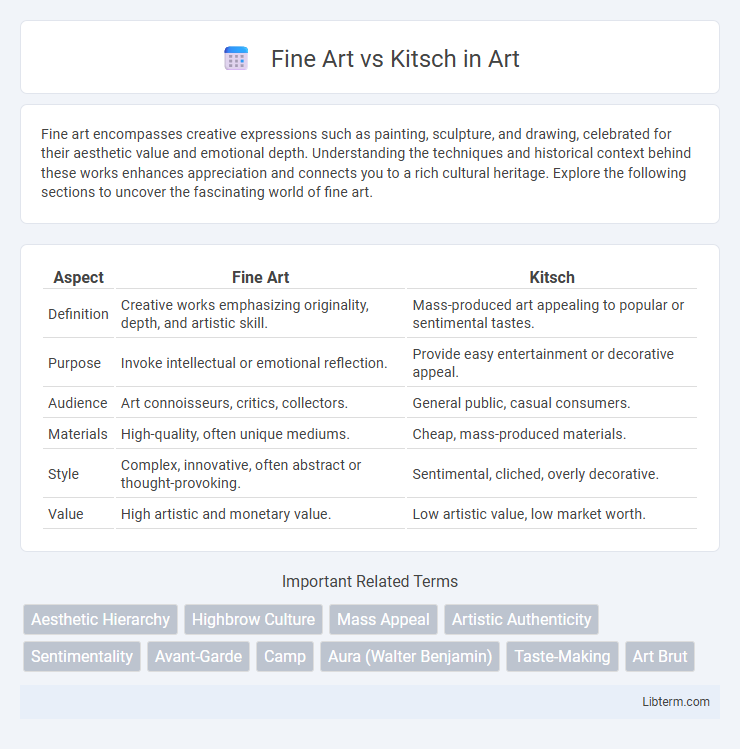Fine art encompasses creative expressions such as painting, sculpture, and drawing, celebrated for their aesthetic value and emotional depth. Understanding the techniques and historical context behind these works enhances appreciation and connects you to a rich cultural heritage. Explore the following sections to uncover the fascinating world of fine art.
Table of Comparison
| Aspect | Fine Art | Kitsch |
|---|---|---|
| Definition | Creative works emphasizing originality, depth, and artistic skill. | Mass-produced art appealing to popular or sentimental tastes. |
| Purpose | Invoke intellectual or emotional reflection. | Provide easy entertainment or decorative appeal. |
| Audience | Art connoisseurs, critics, collectors. | General public, casual consumers. |
| Materials | High-quality, often unique mediums. | Cheap, mass-produced materials. |
| Style | Complex, innovative, often abstract or thought-provoking. | Sentimental, cliched, overly decorative. |
| Value | High artistic and monetary value. | Low artistic value, low market worth. |
Defining Fine Art: Characteristics and Criteria
Fine art is characterized by its emphasis on creativity, originality, and technical skill, often aiming to evoke intellectual and emotional responses. It adheres to established aesthetic criteria, including balance, harmony, and composition, while reflecting deeper cultural, historical, or philosophical significance. Unlike kitsch, fine art maintains authenticity and complexity, challenging viewers and resisting mass-produced or superficial appeal.
Understanding Kitsch: Origins and Features
Kitsch originates from the German word meaning "trash" or "gaudy," often describing art that appeals to popular or lowbrow taste through sentimental or overly decorative elements. Characterized by mass-produced, cliched, and emotionally manipulative imagery, kitsch prioritizes immediate aesthetic pleasure over intellectual depth or originality. Understanding kitsch involves recognizing its commercial nature and how it contrasts with fine art's emphasis on authenticity, form, and conceptual complexity.
Historical Perspectives on Fine Art and Kitsch
Historical perspectives on fine art trace its roots to classical antiquity, emphasizing originality, skill, and aesthetic value, often associated with the Renaissance and Enlightenment ideals that elevated artistic expression as a marker of cultural sophistication. Kitsch emerged in the 19th and 20th centuries, characterized by mass-produced, sentimental, and accessible objects that prioritize emotional appeal over technical or conceptual depth. The academic distinction between fine art and kitsch reflects broader social and cultural hierarchies, shaping how art is evaluated, preserved, and consumed across different historical periods.
Cultural Impact of Fine Art versus Kitsch
Fine art profoundly shapes cultural identity by fostering critical thinking, emotional depth, and innovative expression, often reflecting societal values and historical context. Kitsch, while widely accessible and emotionally appealing, tends to reinforce stereotypes and superficial aesthetics, limiting its cultural influence to mass consumerism and momentary trends. The enduring legacy of fine art lies in its ability to challenge norms and inspire meaningful dialogue, contrasting with kitsch's focus on instant gratification and imitation.
Popularity and Accessibility: Bridging Art and Audience
Fine art often appeals to niche audiences due to its complexity and high cultural capital, whereas kitsch enjoys widespread popularity for its relatable and accessible themes. Accessibility in kitsch allows mass audiences to engage with art without extensive background knowledge, bridging gaps between artists and the general public. The popularity of kitsch challenges traditional art hierarchies by emphasizing emotional connection and immediate recognition over elitism.
Emotional Response: Authenticity vs. Imitation
Fine art evokes a profound emotional response through authenticity, engaging viewers with original creativity and genuine expression that resonates deeply. Kitsch relies on imitation and superficial charm, often triggering shallow or nostalgic feelings lacking the complexity of true artistic experience. The emotional impact of fine art stems from its unique ability to challenge, inspire, and connect, whereas kitsch offers predictable, mass-produced sentiments.
Fine Art in Contemporary Society
Fine art in contemporary society embodies originality, aesthetic depth, and cultural significance, distinguishing itself from kitsch by challenging viewers with complex concepts and innovative techniques. It often serves as a reflective medium for social issues, pushing boundaries through diverse forms including digital art, installations, and performance. Institutions, collectors, and critics prioritize fine art for its ability to provoke thought, influence cultural discourse, and maintain artistic integrity beyond commercial appeal.
Kitsch in Pop Culture and Consumerism
Kitsch in pop culture manifests through mass-produced, sentimental objects that prioritize immediate emotional appeal over artistic depth, often flooding markets with nostalgic or humorous motifs. Consumerism drives the widespread demand for kitsch by commodifying accessible, easily recognizable designs that resonate with popular trends and celebrity culture. This phenomenon reflects a broader cultural shift where aesthetic value is frequently measured by commercial success and mass appeal rather than originality or craftsmanship.
Navigating the Fine Line: When Art Becomes Kitsch
Navigating the fine line between fine art and kitsch involves recognizing the nuanced qualities that elevate authentic artistic expression versus mass-produced sentimentalism. Fine art embodies originality, emotional depth, and intellectual engagement, while kitsch often relies on cliche, superficial appeal, and predictable motifs. Understanding cultural context and audience perception helps discern when art crosses into kitsch territory, affecting its value and meaning.
The Future of Artistic Value: Blurring Boundaries
Emerging trends in the art world reveal a blurring of boundaries between fine art and kitsch, challenging traditional hierarchies of artistic value. Contemporary artists increasingly incorporate kitsch elements to subvert conventional aesthetics, fostering a dynamic dialogue about authenticity and mass culture. This fusion reshapes perceptions of creativity, emphasizing cultural relevance and emotional impact over conventional standards of artistic merit.
Fine Art Infographic

 libterm.com
libterm.com